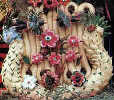| Art Q&A > Crafts |
|
|
Dough Sculpture
Written records on Chinese dough sculptures date back to the Han Dynasty (206BC-AD220). After several thousand years of inheritance and development, dough sculptures became a part of Chinese culture and folk arts, and also objects for study in history, archeology, folk arts, sculpture and aesthetics. In terms of style, dough sculptures in the Yellow River Valley are simple, crude, unconstrained and profound, while those in the Yangtze River Valley are delicate, exquisite and polished.
Materials and tools used in making dough sculptures mainly include white flour, scissors, a kitchen knife, comb, Chinese dates and Bunge prickly ash. With well-leavened dough, kneaded according to the set pattern, one can produce a vivid dough sculpture.
Dough sculptures are popular wedding and birthday gifts. They are also considered appropriate for prayer and memorial ceremonies and sacrificial offerings. Farmers place steamed dough sculptures before spirit tablets. Today, dough sculptures often appear among dishes on high-grade banquets to beautify and decorate the dishes, and add foils to the banquet atmosphere. |
||
All rights reserved. Reproduction of text for non-commercial purposes is permitted provided that both the source and author are acknowledged and a notifying email is sent to us. |
||
 |

